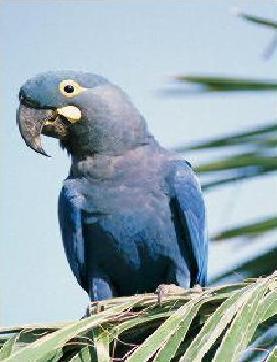Macaw - Lear's
Lears Macaw, Blue Macaw, Indigo Macaw Scientific Name: Anodorhynchus leari
Wed, 30th April, 2025 - 3:13 pm GMT
Sponsor Ads:

Alternative Name
Lears Macaw, Blue Macaw, Indigo Macaw Scientific Name: Anodorhynchus leariBasic Info
Lear's Macaws grow to be about thirty inches in length and were involved in the pet trade for years under the assumption that they were a coloration pattern of the Hyacinthine Macaw due to the similarities in their appearance! Also known as the Blue Macaw or the Indigo Macaw, the plumage is a lovely bright blue color. The head, chest, neck, and abdomen are more of a teal, green-blue color. Lear's Macaws have tail- and wing- undersides, which are a blackish color in addition to their black beak. The bare area immediately surrounding the lower mandible is often a yellowish color, and Lear's Macaws have dark gray feet! The eyes are yellow with a dark brown pupil.
Health
In captivity, they should be fed a standard Macaw diet of fruits, vegetables, seeds, nuts, greenfood, and a vitamin supplement. Lear's Macaws have strict protein requirements, which call for dried shrimp or chicken or meaty chop bones to supplement their diets. Do not keep the social Lear's Macaw alone, as they do best in pairs. Do not keep Lear's Macaws in temperatures below 60 degrees Fahrenheit. Breeding In the wild, Lear's Macaws breed from December to May and generally produce one or two eggs. Nesting sites are established on the same cliff but not within sight of other nests. Predation and poaching mean that most hatchling Lear's Macaws die, and not all pairs mate often or at all. In captivity, Lear's Macaw produces a clutch of about two eggs. They need an absolutely undisturbed nesting box of about 20 by 24 by 30 inches with an entry hole of about seven inches in diameter. Macaws may become aggressive during the breeding season and attack like-sized birds and their keepers. The fledgling period lasts about ninety days and three weeks later the young will be independent. They may be hand raised on biscuit, egg food, porridge, or white bread. Immature Lear's Macaws have shorter tails and lighter colored upper mandibles than adults.Habitat
N/ABehavior
Identified as a species in 1978, Lear's Macaw is extremely endangered despite its relative novelty! These lovely large birds need our help in order to remain in existence. Lear's Macaw lives in groups of eight to 30 birds in the wild, divided into mating pairs. Usually these social birds spend the day foraging for food, relying mainly on the fruits of licuri palms and also eating other ripe and unripe fruits, seeds, nuts and greens. Lear's Macaws nest in holes in rocky cliffs and in treetops. They love to squawk among themselves but are extremely shy in dealings with other animals and people. Sentinel Lear's Macaws will "scout out" areas before the flock follows them! In captivity, Lear's Macaws can be taught to talk but do not have an extensive vocabulary. They love to chew and will need lots of sturdy branches in their enclosure, which should be made of a metal strong enough that they cannot chew through it! Generally, a 30 by nine by eight-foot enclosure with an enclosed large shelter abutting it is perfect for Lear's Macaws. They form strong bonds with their keepers and have inquisitive, confiding personalities.Lear's Macaws are noisy like most Macaws but may be kept with other birds outside of their breeding season! They love to bathe and also quite enjoy being "rained on" with a garden hose during flight, especially in the summer!Origin
BrazilHistory
Lear's Macaw exists only in the province of Bahia in northern Brazil. The drought-prone caatinga scrubland and isolated, craggy, rocky cliffs provide their habitat. Lear's Macaw was stolen from the wild for centuries in the pet trade, under the assumption that it was a color aberrance of a known species of Macaw, until Helmut Sick in 1978 identified it as a separate species. Today, less than 200 Lear's Macaws exist in the wild due to illegal capture for the pet trade and hunting for food, depletion of the licuri palm for livestock and agriculture, and habitat loss to livestock and agriculture. Recent illegal captive Lear's Macaw seizures have led to the prospect of a captive breeding program, but currently combined efforts at conservation have concentrated on protecting Lear's Macaw within their habitat. Fundacao Biodiversitas in Brazil has established protected land at the Lear's Macaw's breeding grounds, Raso de Catarina, and patrols it with guards to protect against poachers. Funds have also been allocated to encourage local farmers to grow licuri palm stands for the birds and educational programs have been instituted to raise local people's awareness about Lear's Macaw's predicament. Financing such programs has proved extremely difficult and about 15 Lear's Macaws per year are still captured from the wild. Unless something changes, the future of Lear's Macaws remains extremely uncertain.Common Foods
In captivity, they should be fed a standard Macaw diet of fruits, vegetables, seeds, nuts, greenfood, and a vitamin supplement. Lear's Macaws have strict protein requirements, which call for dried shrimp or chicken or meaty chop bones to supplement theirSponsor Ads:
Sometimes, a cigar is just a cigar. - S. Freud -- Unknown
Macaw - Lear's
Coded by: BGID® | ALL RIGHTS RESERVED Copyright © 2000-2025
Disclaimer | Privacy | Report Errors / Contact | Credits
















